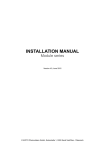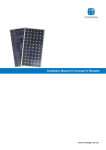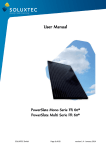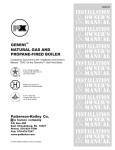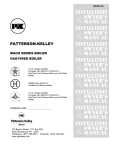Download GSE INTEGRATION INSTALLATION MANUAL
Transcript
GSE INTEGRATION INSTALLATION MANUAL Photovoltaic mounting system for partial or complete roof covering MCS CERTIFICATE BBA 0156 V 10.2 WWW.GSEINTEGRATION.COM Contents STEP BY STEP Presentation of system p.4 Contents of kit GSE Integration mounting plates p.5 p.6 - 7 Tools required for installation p.8 Implementation prescription p.9 - 11 GSE Integration Installation steps p.12 - 32 Maintenance p.33 Assistance & Contact p.34 Our Certifications p.35 Examples of completed installations p.36 - 37 3 Presentation of system GSE INTEGRATION IN ROOF SYSTEM The GSE Integration system is used to install modules on all types of roofing, (curved tiles, mechanical, flat, slates), on new buildings or buildings being renovated. The system may be installed in portrait format or in landscape format, with a specific mounting plate for each format, on both small installations (less than 3 kWp) and large roofs (several hundred kWp). The GSE Integration system may be installed on wood or metal structures and mounted on battens or lathing. It can also be mounted directly on common rafters and can be installed on slopes between 15° and 50°. The GSE Integration system is guaranteed for 10 years, provided the installation recommendations given below are respected. The system does not require much maintenance, except for regular cleaning of the solar panels. 4 Contents of kit Tools required for installation p. 8 Dimensions of Photovoltaic field on the roof p. 18 ASSEMBLY ACCESSORIES 2 1 3 Flashings 4 5 6 7 8 9 10 Mounting Plates 11 12 13 14 Waterproofing 15 ASSEMBLY ACCESSORIES 16 FLASHINGS 1. Stainless Steel Screw 6.5 x 60mm + EPDM 4. Flashing Hooks Washer 5. Left and Right Top Flashings + Screw 4.8x25mm 2. Cellular EPDM Joint 21x25mm or 23x45mm 6. Top Center Flashing 3. 2014 Single and double renforceer clamps 7. Aluminum Pop Rivet 8. Top Corner Piece (For top Center Flashing) 9. Lateral Flashing + Screw 4.8x25mm 17 MOUNTING PLATES WATERPROOFING 15. Waterproofing Strip 11. Screw 6.5x60mm + EPDM Washer 16- Precompressed Seal Rool 20x40mm 12. GSE Portrait Plate 17. Roof Underlay Screen 13. GSE Landscape Plate 14. Lef tand Right Wedge 10. Top Flashing Junction 5 Mounting plate 1.0 PHOTOVOLTAIC PANELS - LANDSCAPE FORMAT Upper mounting plate PV Panel Support Upper mounting plate PV Panel Support Water Drainage Guide Photovoltaic panel mounting plate and guide Clamp Fixation Zone Mounting point on structure, min. 6x Clamp Fixation Zone Photovoltaic panel mounting plate and guide Cable outlet Water Drainage Zone Reference Fixation Point : DO NOT PRE-DRILL Fixation Point needing pre-drilling LANDSCAPE PLATE REFERENCE + MODULE SIZES MODULES TOLERANCE Graduated overlapping zone Height Tolerance 6 Width Tolerence Photovoltaic panel support REF. Height (mm) Width (mm) 1640 / 990-1001 952-1032 1641-1629 1650 / 990-1001 952-1032 1651-1639 1660 / 990-1001 952-1032 1661-1649 1670 / 990-1001 952-1032 1671-1659 1675 / 990-1001 952-1032 1676-1664 1680 / 990-1001 952-1032 1681-1669 1575 / 1082 1042-1122 1576-1564 1559 / 1046-1082 1042-1122 1560-1548 1580 / 808 768-848 1581-1569 Mounting plate 1.1 PHOTOVOLTAIC PANELS - PORTRAIT FORMAT Upper mounting plate PV Panel Support Photovoltaic panel mounting plate and guide Cable outlet Clamp Fixation Zone Water Drainage Guide Mounting point on structure, min. 6x Clamp Fixation Zone Water Drainage Zone Photovoltaic panel support Fixation Point needing pre-drilling Reference Fixation Point : DO NOT PRE-DRILL Photovoltaic panel mounting plate and guide PORTRAIT PLATE REFERENCE + MODULE SIZES MODULES TOLERANCE Graduated overlapping zone Height Tolerance REF. Height (mm) Width (mm) 1640 / 992 1600-1680 991-980 1640 / 1001 1600-1680 1002-989 1559 / 1046 1535-1615 1047-1037 1575 / 1069 1535-1615 1070-1058 1575 / 1082 1535-1615 1083-1071 1580 / 808 1540-1608 809-797 Width Tolerence 7 Tools required for installation CHALK LINER SCREWDRIVER HAMMER PLATE SHEAR Adjustable torque necessary DRILL BITS POP RIVET PLIER • WOOD AND METAL DRILL BIT ø 10 mm • 6 PAN BIT ø 8 mm MEASURING TAPE – WHITE MARKER OR PENCIL 8 Implementation prescription 1.0 ROOF FRAME / WIND ZONE CORRELATION 12 ° to 50 ° normal site (catеgorie IIIa) 2 roof slopes Battens thickness min board width Battens thickness min board width Zone 4 min board width Zone 3 Battens thickness Zone 2 min board width Zone 1 Battens thickness The indicated values in the tables below apply only for wind zones 1 through 4, and for an altitude inferior to 900 meters. 15 22 27 40 22 27 40 40 40 22 27 40 30 210 110 100 100 150 100 100 130 100 150 120 100 150 15 22 27 40 22 27 40 40 40 22 27 40 30 260 120 100 100 200 120 100 130 100 150 120 100 160 15 22 27 40 22 27 40 40 40 22 27 40 30 220 150 100 100 220 140 100 130 100 150 120 100 200 15 22 27 40 22 27 40 40 40 22 27 40 30 240 170 110 100 250 170 100 130 100 150 120 100 220 40 100 40 100 40 120 40 130 15 22 27 40 22 27 40 40 40 22 27 40 30 40 200 130 100 100 200 130 100 130 100 150 120 100 180 100 15 22 27 40 22 27 40 40 40 22 27 40 30 40 220 160 110 100 160 160 100 130 100 150 120 100 160 180 120 15 22 27 40 22 27 40 40 40 22 27 40 30 40 260 180 120 100 180 180 100 140 100 160 130 100 180 140 15 22 27 40 22 27 40 40 40 22 27 40 30 40 300 210 150 100 210 150 100 160 120 150 120 100 200 160 15 22 27 40 22 27 40 40 40 22 27 40 30 40 200 140 100 100 150 140 100 130 100 130 100 100 140 120 15 22 27 40 22 27 40 40 40 22 27 40 30 40 250 170 120 100 170 170 100 130 100 150 120 100 160 130 15 22 27 40 22 27 40 40 40 22 27 40 30 40 280 160 140 100 200 200 100 150 100 180 140 100 200 150 22 27 40 22 27 40 40 40 22 27 40 30 40 160 100 100 230 150 100 180 120 250 160 100 250 140 150 Main roof wall 10M height Note Size in mm Battens spacing ≤ 600 spacing trusses or rafters 600 ≤Battens spacing ≤ 900 spacing trusses or rafters Battens spacing ≤ 1500 metal trusses Battens spacing ≤ 1500 (1) Battened frame Battens spacing ≤ 1500 (1) Metal or wood frame Side edge 10M height Battens spacing ≤ 600 spacing trusses or rafters 600 ≤Battens spacing ≤ 900 spacing trusses or rafters Battens spacing ≤ 1500 metal trusses Battens spacing ≤ 1500 (1) Battened frame Battens spacing ≤ 1500 (1) Metal or wood frame Angle 10M height Battens spacing ≤ 600 spacing trusses or rafters 600 ≤Battens spacing ≤ 900 spacing trusses or rafters Battens spacing ≤ 1500 metal trusses Battens spacing ≤ 1500 (1) Battened frame Battens spacing ≤ 1500 (1) Metal or wood frame (1): Layout of the woods in the direction of the slope 9 Implementation prescription 2.0 GSE INTEGRATION MECHANICAL RESISTANCE (PASS'INNOVATION N°2013-221) TESTED WIND ZONES Depression calculation N / m2 (Pa) calculated in the case of slopes plans (V65 with following rules amending No. 2) Table 1.1 - Slopes Plans - Rolled ribbed steel wood and derived products - New Construction - Buildings closed Height (m) Position Normal Exposed Normal Exposed Normal Exposed Normal Exposed Normal Exposed Main wall Side Edge Angles Main wall Side Edge Angles Main wall Side Edge Angles Main wall Side Edge Angles Main wall Side Edge Angles x4 Reinforced clamps 2014 (resistance 1860 Pa - security coef. 1.5) x6 Reinforced clamps 2014 (resistance 3460 Pa - security coef. 1.5) Roof zones - rule V65 Wind zones - rule V65 10 On a building 15m high, the entire roof surface can be used. Implementation prescription 3.0 DILATATION (example: GSE Landscape Plate Réf. 1660/992) Fixed Reference Points Dilatation of the Clamp fixation points mm Dilatation of the mounting plate fixation points Fixed Reference Points 8mm on 4 points = 2mm/point 6mm on 3 points = 2mm/point 4mm on 3 points = 1,33mm/point 4mm on 4 points = 1mm/point The dilatation between the mounting plate and the wood batten requires a pre-drilling of the plate with a ø 10 mm drill bit at the points where you will be fixing your Dilatation of the Clamp fixation points Dilatation of the mounting plate fixation points clamps as well as the points where you will be fixing the mounting plate on the roof structure. 11 Installation Steps 1.0 COVER PREPARATION Info : Please remember to download our layout calculator at: www.gseintegration.com, to help you determine the exact field quotes. Intermodule of 5mm advised Field Height: ± intermodule of 5mm + module height x number of modules + 150 mm (for waterproofing strip on tile) + 320 or 200 mm Field Height Field width: ± 60mm + intermodule of 30mm + module width x number of modules + (2 x 150 mm) Field Height Calculate the PV Field Size Landscape installation Portrait Installation • Make sure to uncover 200mm on each side for the lateral flashings. • In case of Top flashings use, make sure to uncover at least 320mm above the top module. 1) Remove the cover elements on the above-calculated width. 2) Take out an extra row of tiles on the left and on the right (2 rows for slate, or flat tiles) 3) Also remove the cover elements on the calculated height above. 4) Take out one row of tile on the top part (2 rows for slate or flat tiles) Photovoltaic field calculated above Slate roof : 2 extra rows taken out. 12 Photovoltaic field calculated above Tile roof : 1 extra row taken out. Installation Steps 2.0 LATHING PREPARATION ACCORDING THE THE MOUNTING PLATE Lathing for Portrait Installation – Traditional Roof Structure (cf. Tables on P.9) 43 cm 25 cm 123 cm 90 cm 180 cm 159 cm 212 cm 195 cm 260 cm 328 cm 292 cm 350 cm EXAMPLE BELOW: SPACING BETWEEN BATTENS 60cm – LATHING 27x100mm – MODULE 1675mm in Length) 100mm to 120mm: minimum covering with the waterproofing strip LATHING FOR PORTRAIT INSTALLATION – INSTALLATION ON PAN STEEL (cf. tables on P.9) EXAMPLE BELOW: SPACING BETWEEN BATTENS 60cm – LATHING 27x100mm – MODULE 1675mm in Length Existing batten: Spacing of 150 cm added intermediate wooden batten : If spacing is > 150 cm 18 cm 85 cm 103,5 cm 13 Installation Steps 2.1 LATHING PREPARATION ACCORDING TO THE MOUNTING PLATE 26 cm 74 cm 100mm to 120mm: minimum covering with the waterproofing strip 54 cm 113 cm 92 cm 193 cm 176 cm 155 cm 127 cm 215 cm Lathing for Portrait Installation – Traditional Roof Structure (cf. Tables on P.9) EXAMPLE BELOW: SPACING BETWEEN BATTENS 60cm – LATHING 27x100mm – MODULE 1001mm in Length LATHING FOR LANDSCAPE INSTALLATION – INSTALLATION ON PAN STEEL (cf. tables on P.9) EXAMPLE BELOW: SPACING BETWEEN BATTENS 60cm – LATHING 27x100mm – MODULE 1675mm in Length Existing batten: Spacing of 150 cm added intermediate wooden batten : If spacing is > 150 cm 18,5 cm Remember to verify with the module manufacturer’s installation notice the compatibility of the module with the fixation clamps on the small side. 14 40 cm 85 cm 128,5 cm 150 cm 169 cm Installation Steps 3.0 INSTALLING THE WATERPROOFING STRIP 1.1) In the case of a shallow slope or thick roofing elements (e.g. curved tiles) or very shaped roofing elements, in order to avoid standing water, install two 2 wood planks dimensioned according to following table (on the entire field width and of sufficient thickness to allow water to be evacuated correctly). 1.2 ) Unroll the waterproofing strip (self adhesive preferably) on the prepared lathing, making sure that it exceeds the PV field by 20cm on each side. 1.3) Fold back the upper edge of the waterproofing strip around 2cm 1.4) Fold back the right and left ends in the same way. 1.5 ) Firmly press the waterproofing strip onto the first row of tiles, pressing it down smoothly and carefully (ensure that you don’t create any water trap zones) The strip should cover the pan as follows : - 12 cm for tiles that are very curved (curve of over 3cm) - 10cm for flat tiles or slightly curved (curve of less than 3cm) Installation on curved tiles requires a waterproofing strip 45 to 56 cm wide. Superior edge have to be folded 2cm IMPLEMENTATION DRAWING (1.4) Roof slope (°) Battens width implementation (mm) 12 tot 16 17 tot 19 20 tot 24 25 tot 50 220 180 150 120 15 Installation Steps 4.0 INSTALLING THE FIRST ROW OF MOUNTING PLATES 1.1) Using the chalk liner, mark a line on the waterproofing strip, parallel to the battens and 15 cm to 20 cm below the top edge of the waterproofing strip. The plate will cover 12 cm. 1.2) Position the first mounting plate in the bottom righthand corner of the uncovered area, aligned with the chalk liner mark. Install the mounting plate. Screw the mounting plate using the 2 central fixing points that do not need pre-drilling (see mounting recommendations on pages 6, 7, 13 and 14). 1.3) Place your second mounting plate next to the first one, making sure that they interlock. Same for the mounting plates on the second row and the rows above, etc. Mounting plate wave 1.4) Using the pencil or white marker, mark the future clamp fixation points, on the mounting plates waves, according to the lathing that has been implemented. Once the plates have been installed, these marks will allow you to fix the clamps at the right position, and aligned. (see fixation recommendations on pages 9 to 17). Tip : : To determine the placement of fixation of the clamps on the module, you can use the module cells as marks. INSTALLATION THE FOLLOWING ROWS OF MOUNTING PLATES The mounting plates above need to overlap the mounting plates below all the way until in contact with the dedicated stops. The overlap hence will be of 12 to 16cm depending on your module height. (p. 6/7) 16 Installation Steps 5.0 PRE-DRILLING OF THE MOUNTING PLATES WITH A DRILL BIT OF ø 10 mm Clamp Fixation on high point of the mounting plate. Stainless Steel Screw 6.5x60mm + EPDM Joint + cellular EPDM foam Fixation of the mounting plate on the roof structure Stainless Steel Screw 6.5x60mm + EPDM Joint Fixation and preparation of the mounting plates EPDM Washer ø 16mm Pre-drilling ø 10mm Cellular EPDM foam 21x25mm EPDM Washer ø 16mm Pre-drilling ø 10mm Stainless Steel Screw ø 6,5mm Mounting plate to roof structure fixation drawing (only 4 of the 6 fixation points) Stainless Steel Screw 6.5x60mm + EPDM Joint Stainless Steel Screw ø 6,5mm Clamp fixation drawing on the mounting plate Stainless Steel Screw 6.5x60mm + EPDM Joint + cellular EPDM foam Make sure to correctly position the screw at the center of the pre-drilled hole in order to ensure waterproofing longevity. A tolerance has been calculated to this effect during the product design phases. 17 Installation Steps 5.1 REMINDER During the preparation of the roof structure, it is necessary to install a roof underlay screen, up to the gutter. DIRECTION OF THE APPLICATION Please remember to overlap the mounting plates, 12cm to 16 cm, depending on your module size. (You can adjust this overlap with the graduation on the mounting plate – (cf. “GSE Intgration Plates adjustment” Section). The mounting plates are preferably installed from right to left but can also be installed left to right (make sure the plates are properly interlocked) 18 Installation Steps 6.0 CLAMPS FIXATION (draw 2) 1 2 3 14 The clamps are to be fixed only on the mounting plate edge (draw 2) Attach the clamps (3) using the screws to this effect (1) making sure to stick the EPDM foam (2) between the clamp and the mounting plate to ensure waterproofness. For single clamps fixation, make sure to position the left and right wedges (14) correctly inside the edge of the mounting plates. Make sure the wedges are positioned before the lateral flashings. Make sure to fix the clamps on the wood battens. It is imperative to stick the EPDM foam (2) under the clamp (between the mounting plate and the clamp). FIXING THE CLAMPS ON THE MOUNTING PLATES 2 or 3 clamps per wave 2 or 3 clamps per wave The use of the various clamps varies according to the wind zones, but needs also to respect the PV module manufacturer’s recommendations. The majority of PV modules have a resistance to wind depression of 2400Pa. The reinforced clamps being valid all the way to 3400Pa, it is important to have the manufacturer’s authorization to go over 2400 Pa (cf Table p.10) 19 Installation Steps 6.1 NOTE Make sure you interlock the mounting plates correctly in order to ensure proper waterproofing of the system. View of 4 interlocked mounting plates Double clamps fixation 3 x2 4 1 20 1 Stick the cellular EPDM foam under the clamp 2 Tighten the screw once and take it out 3 Repeat 4 cellular EPDM Tighten the clamp in its position Clamps attachment points on the PV panel after screwing. Installation Steps 7.0 GSE PLATES ADJUSTMENT The GSE Integration Plates are adjustable according to your panel size. In order to adjust the GSE plates, use the graduations on the plate. The graduation vary from 0 to 40 mm. After having screwed all the mounting plates at the 2 center points, you can start preparing your ø 10 mm drill bit. And pre-drill all the other holes on the plate, that means 4 pre-drills on top of the 2 fixing points already made. GSE PORTRAIT MOUNTING PLATE Ex: the H1640-80mm x W992mm can fit a panel 1640 to 1680 mm high, and 992mm wide Graduated overlapping zone GSE LANDSCAPE MOUNTING PLATES Ex: the 1640mm Wide x 992-1032 mm long plate can fit a panel 1640 mm high and 992 to 1032mm wide Graduated overlapping zone *Cf. Tables on p.6-7 21 Installation Steps 7.1 ADJUSTMENT EXAMPLES (1650 MM MODULES IN PORTRAIT) GSE PORTRAIT MOUNTING PLATE (H1640-80mm X W992mm) For a H1650 mm panel, position the plate at 10mm back For a H1660 panel = 20 mm back Graduated overlapping zone GSE LANDSCAPE MOUNTING PLATE (W1640mm X H992-1032mm) For a panel H1002, position the plate at 10mm back For a panel H1012 = 20mm back Graduated overlapping zone 22 Installation Steps 8.0 WEDGES POSITIONNING The 2014 Version of the GSE Intgration System requires positioning wedges on the lateral parts of the field. These wedges are to be placed under the plate wave at the edge, right under where the clamps will be fixed. • Please note that there is a left and a right wedge • The wedge will be drilled with the plate and lateral flashing, before fixing the single clamp. 23 Installation Steps 9.0 INSTALLATION OF THE LATERAL FLASHINGS 1.1) Position the lateral flashings overlapping the waves on the right and left edges of the integration system. 1.2) Use a screw 4.8x25mm at the junction of 2 lateral flashings to fix them together. 1.3) Then, position the single clamp where you marked the mounting plates. Mark the pre-drilling point on the lateral flashing. 1.4) Pre-drill a 10mm hole, making sure you go through the lateral flashing, the plate and the wedge. Overlapping of 15 cm The flashings interlock each other, with the top part over the bottom part to allow proper water drainage 1) Open the lateral clip over 10 to 15 cm (lower lateral flashing). 2) Interlock the upper lateral flashing on the lower one, then re-close the clip 3) Fix the lateral flashing to the roof structure using the flashing hooks (5) Upper lateral flashing to be interlocked on the lower one. Open the lateral clip over 10 to 15 cm. Position and install the upper skirt and clip, and close the clip. Fix the lateral flashing on the battens using the flashing hooks (5). The overlap of one lateral flashing on top of the other needs to be 15 cm 24 Installation Steps 10.0 INSTALLING THE PHOTOVOLTAIC PANELS Place the first row of panels on the mounting plates. The panel is installed on the 2 upper supports on the plate. PASSING THE CABLES (1) Note: Cables must transit from one panel to the next through the dedicated cable outlets : Slot through the central protection pad 1 (1 & 2) Passing the cables 2 If you are using optimizers or micro-inverters, you can fix them in the center hole of the mounting plate, on the visible wood battens without risking the module to press on your equipment. OPTIMIZERS OR MICROINVERTER Compatibility approved for : 25 Installation Steps 10.1 PASSING THE CABLES Panels should be connected horizontally when installed in portrait format. The panel can be installed upright or inverted. INSTALLATION FOR PANELS OF MINIMUM 40MM THICKNESS INSTALLATION FOR PANELS OF THICKNESS between 31mm and 50mm ELECTRICALLY EARTHING THE PANELS The photovoltaic panel should be earthed through the dedicated hole in alloy frame of the photo-voltaic panel BLOCK DIAGRAM FOR SINGLE STRING WIRING Good wiring practice is to limit the INDUCED loop lengths Chassis earthing Inverter DC input AC BOX INVERTER DC BOX Panels earthed directly on the house earthing stake. Earthing terminals 26 Installation Steps 10.2 MOUNTING THE PHOTOVOLTAIC PANELS 1/ For fixation of the PV Panel to the plate you will have to use one of the two possible clamps (cf. p.14 or below) 2/ use the pre-drilled holes (1.4 p.24) in the lateral flashings and the wedges to position your 3 clamps per panel side. ??? 3/ Before fixing the clamps, stick the EPDM Joint under the clamps to ensure waterproofing. Use the 6.5x60mm screw supplied. 4/ The double clamps fix the panels 2 by 2 and align to the single clamps. 5/ The single clamps are fixed at the edge of the PV Field, align to the double clamps and are position over the wedges that are under the plate wave. BE CAREFUL TO SCREW THE ELEMENTS WITH THE RIGHT FORCE Too weak correct Too strong Diagram of clamps positioning For landscape fixation, please refer to the PV panel manufacturer’s notice. Single Clamps Double Clamps TESTED WIND ZONES Height (m) Position Normal Exposed Normal Exposed Normal Exposed Normal Exposed Normal Exposed Main wall Side Edge Angles Main wall Side Edge Angles Main wall Side Edge Angles Main wall Side Edge Angles Main wall Side Edge Angles x4 Reinforced clamps 2014 (resistance 1860 Pa - security coef. 1.5) x6 Reinforced clamps 2014 (resistance 3460 Pa - security coef. 1.5) 3 *Cf table p. 9-10 27 Installation Steps 11.0 INSTALLING THE TOP FLASHINGS 1/ The tile or zinc covering the top flashings should be at least of 15 cm. In case of a shallow slope or a tile of high curve, the covering should be more. 2/ On slate, a 10cm covering is enough. Last tile Last tile 10 cm 5 cm 10 cm PREPARATION OF THE TOP CORNER PIECE (FOR TOP CENTER FLASHING) Top Corner Piece Pop Rivets (8) Use the pop rivets (8) supplied with the kit and mount the corner bead on the central edge joiner. Each hole corresponds to a panel thickness. The first hole is used when installing the central edge joiner with panels 50 mm thick, the second hole for 45 mm panels, the third hole for 40 mm panels and the last hole for 35 and 31mm panels. 31 35 45 40 50 31 35 45 40 50 31 35 45 Top Corner piece facial view 28 40 50 31 35 45 40 50 Installation Steps 11.1 MINIMUM ROOF SLOPE FOR FLASHINGS INSTALLATION ACCORDING TO THE THICKNESS OF THE PV PANELS. MINIMUM TOP FLASHING PITCH : 5° Top Flashing Length Sensor Height Pitch Flat Section PANEL THICKNESS MINIMUM ROOF SLOPE (°) MINIMUM ROOF SLOPE (%) 35 40 46 50 14 15 16 17 31% 33% 37% 39% A batten may be installed Length Pitch Sensor Height Flat Section H paneel Slope (°) Slope (%) Batten X (mm) Slope (°) Slope security (°) A 5° margin is of course taken into account. This information is only a guide. Care should be taken to ensure that all roofing regulatory requirements are met. 29 Installation Steps 11.2 Installation of top flashings 1/ Place the top center flashing, having made sure first that the top corner piece is fixed to the top center flashing (see p.28). To do so, clip the module in the space created by the top corner piece, and then fix the top center flashing piece to the roof structure using the flashing hooks. Sensor Height (1) Add 2 lines of PU adhesive between the junction and the top center flashing. (1) 2/ Ensure that 2 top flashing pieces are connected together with the “Top Flashing Junction” piece. (2) Apply two vertical beads of PU adhesive to ensure waterproofing. 3/ Place the Top left and top right flashing pieces on top of the top center flashings and the lateral flashings. 100 mm (3) 100 mm Once the top corner flashings are positioned, use the 4.8x25mm screws supplied. 4.8x25mm screw Apply two vertical beads of PU adhesive to ensure waterproofing. (4) 4/ The top corner flashing can be adjusted to the panel thickness by cutting. Can be cut to fit (5) 5/ In a portrait installation the top corner piece (for top flashings) needs to be cut at the edge of the mounting plate. 30 45 35 50 40 31 45 35 50 40 45 35 31 Top corner piece cut 50 40 31 45 35 50 40 31 Installation Steps 11.3 Replacing Top Flashings with a lead waterproofing strip Lead waterproofing strip is warrantied for 30 years by its manufacturer. It applies like any waterproofing strip or any lead strip. It can be welded as well like traditional zinc. 1/ Unroll the lead waterproofing strip, ensuring that the top of the plate is covered and that the strip is under the tile by at least 15cm. It is hence necessary to adapt the width of the waterproofing strip to respect this rule. 2/ Fold back 2 cm of a the waterproofing strip at the top. 3/ 2. Unroll the precompressed seal on the entire width of the installation, making sure it connects with the precompressed seal on the lateral flashings. • On slopes that are less than 20 degrees, it is imperative to use a lead waterproofing strip at least 45cm wide. • ATTENTION : For slate or flat tiles, put the slate or tiles over the waterproofing strip without covering the GSE plate wave. Otherwise some tiles would be lifted by the plate wave compared to the tiles next to them. Plate waves covering 31 Installation Steps 12.0 INSIDE AND OUTSIDE ANGLE For specific configurations of inside and outside angles, a waterproofing strip is necessary. This installation process answers to roofing regulations. However a few rules need to be followed : Outside Angles / "T" angle • Position the lateral flashing --- Put the GSE plate over the waterproofing strip, making sure that the overlap is at least 12cm and that the strip goes over the all the way to the GSE plate edge wave • Inside Angle / "L" angle --- Position the waterproofing strip on the top of the • plate, as well as over the plate wave that form the inside angle. • Position the lateral flashing from the top of the waterproofing strip to the panels support of the GSE plate beneath Make sure to cut the waterproofing strip at the top of the plate wave to avoid a tear over time. Stop the waterproofing strip at the top of the plate wave 32 Risk of tear Installation Steps 13.0 INSTALLING THE PRECOMPRESSED SEAL (recommended size: W 20 mm / H 40 mm) 1/ Unroll the precompressed seal on the lateral flashings all the way to the bottom of the waterproofing strip. The junction between 2 joints needs to be tight. Precompressed seal 2/ Unroll the precompressed seal on the entire length of the top flashing. m 2c m mi c n. 3 3/ The precompressed seal needs to be put at 2cm from the edge of the lateral flashings. You also need a minimum of 3cm from the edge of the mounting plate in order to have proper water drainage. 33 Installation Steps 13.1 PV FIELD INSTALLATION FINAL STEPS Put back the rows of tiles or slate on top of the lateral flashings and on top of the top flashings, covering enough of the flashings. 34 Maintenance INSPECTION It is important to check once per year whether any leaves or other elements have penetrated under the photovoltaic system. Such elements can be blown out using a compressed air blower. Do not use solvent to clean the mounting plates, which are in polypropylene. It is recommended that you offer your customers a maintenance contract, which would include an annual inspection of : generation, electrical system, panels, panel mounting plates, mountings, precompressed seals, waterproofing strip. REPLACING A MODULE 1/ Power off the PV INSTALLATION. 2/ Remove the clamps from the panel to be replaced. 3/ Disconnect the earthing connection and disconnect it from the string. 4/ Take out the panel that needs to be changed and replace it with the new one. 5/ Connect the new panel to the earth and reconnect it to the string. 6/ put back the clamps. The equipotential connection must be maintained. 35 Assistance & contact training Trainings can be organized with your distributor. Please contact your distributor for further information. TECHNICAL ASSISTANCE TECHNICAL ASSISTANCE IS AVAILABLE WITH YOUR DISTRIBUTOR OR FROM MONDAY TO FRIDAY AT THE CONTACT INFORMATION BELOW. 16 QUAI GUSTAVE FLAUBERT 76380 CANTELEU Tél. 02 32 10 77 60 Mail : [email protected] 36 Our Certifications • “PASS INNOVATION VERT” Nr. 2013-221 – Module ZN Shine ( from oct. 2013 to oct. 2015) THE FRENCH ETN CERTIFICATION AUTHORIZES THE INSTALLATION OF GSE INTEGRATION IN PORTRAIT AND LANSCAPE PROVIDED THAT THE MODULE MANUFACTURER ACCEPTS THE MODULE FIXATION ON THE SMALL SIDE. • ETN INDICE 0 - BT130003 Validated by Alpes-contrôles : *Solarworld Sunmodule + (Mono) – portrait *Soluxtec Powerslate (Mono) – portrait/landscape *Sillia 60P (Poly) – portrait *BenQ PM245 (Poly) – portrait *QCells G3 pro (Poly) – portrait/landscape (1400 Pa) • • ETN INDEX 1 *Solarworld Sunmodule Poly & SunProtect *Sunpower 3XX (Mono) *BenQ SunForte (Mono) *Soluxtec Das module (Poly-Mono) *Aléo S19 HE (Mono) *Csun 60P / 60M (Poly-Mono) *Solarwatt (Poly-Mono-Vision) *LG (Poly, Mono, Mono X) FireTest : *BROOF T1 – Approved (Belgian, Deutsch, and German markets) *BROOF T3 – Approved (French market) *BROOF T4 – Approved (British market) • Mechanical resistance, UV, humidity, weather tests available at www.gseintegration.com • New certification CERTISOLIS Sunpower / BenQ SunForte / GSE Intégration in process • Test EN12179 - Approved • MCS012 - Approved 37 Completed Installations Examples 38 Completed Installations Examples 39 GSE INTEGRATION is a GROUPE SOLUTION ENERGIE patented development program www.segroup.fr Your distributor : GROUPE SOLUTION ENERGIE 155-159 rue du Docteur Bauer. 93400 SAINT OUEN - Tél. : +33(0)1 70 32 08 00 - Fax : +33(0)1 70 32 08 01- email: [email protected]















































